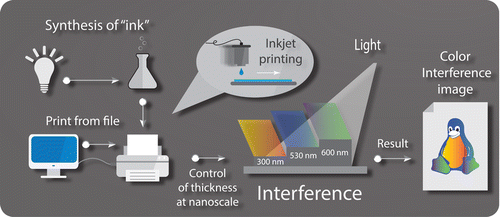From dot-matrix to 3-D, printing technology has come a long way in 40 years. But all of these technologies have created hues by using dye inks, which can be taxing on the environment. Now a team reports in ACS Nano the development of a colorless, non-toxic ink for use in inkjet printers. Instead of relying on dyes, the team exploits the nanostructure of this ink to create color on a page with inkjet printing.
Current technologies blend dyes—think CMYK or RGB—to print in color. But these substances can harm the environment. Some dyes are toxic to marine life or can react with disinfectants like chlorine and form harmful byproducts. An alternative to dyes involves changing the nanostructure of materials so that they reflect light in particular ways. An example of this kind of coloring by light interference is found in nature: Squids can modify the nanostructure of their skin to mirror back their surrounding environment, creating a natural camouflage. Previous research has investigated printing color by light interference, but these attempts have required high-temperature fixing or specialized printing surfaces. Aleksandr V. Yakovlev, Alexandr V. Vinogradov and colleagues at ITMO University wanted to develop a nanostructure color printing technology that is "greener" and can be printed on a wide variety of surfaces.
The team found that a colorless titanium dioxide-based colloidal ink was the best suited for the job. It does not require high temperature fixing and can be deposited on many surfaces. The researchers can control the color produced on surfaces by varying the thickness of ink deposition from a normal inkjet printer. Creating a vibrant color red with this method and this very narrow angle of coloring remains a challenge. This method, however, has generated the first reported "green" ink that is both safe for the ecosystem and does not fade from UV exposure, the researchers say.
More information: Aleksandr V. Yakovlev et al. Inkjet Color Printing by Interference Nanostructures, ACS Nano (2016). DOI: 10.1021/acsnano.5b06074
Abstract
Color printing technology is developing rapidly; in less than 40 years, it moved from dot matrix printers with an ink-soaked cloth ribbon to 3D printers used to make three-dimensional color objects. Nevertheless, what remained unchanged over this time is the fact that in each case, dye inks (CMYK or RGB color schemes) were exclusively used for coloring, which inevitably limits the technological possibilities and color reproduction. As a next step in printing color images and storing information, we propose the technology of producing optical nanostructures. In this paper, we report use of inkjet technology to create colored interference layers with high accuracy without the need for high-temperature fixing. This was made possible due to using titania-based colloidal ink yielding monolithic coatings with a high refractive index (2.00 ± 0.08 over the entire visible range) when naturally dried. By controlling the film thickness by using inkjet deposition, we produced images based on controlled interference and implementing color printing with one ink. The lack of dyes in the proposed method has good environmental prospects, because applied systems based on a crystalline anatase sol are nontoxic and biologically inert. The paper explains in detail the principle of producing interference images by the classical inkjet method and shows the advantages of this technique in depositing coatings with uniform thickness, which are required for large-scale interference color imaging even on unprepared polymer films. This article demonstrates the possibility of inkjet printing of nanostructures with a precision in thickness of up to 50 nm, we believe that the proposed approach will be the groundwork for developing interference color printing approach and allow to implement new methods of forming optical nano-objects by widely available techniques.
Journal information: ACS Nano
Provided by American Chemical Society
























